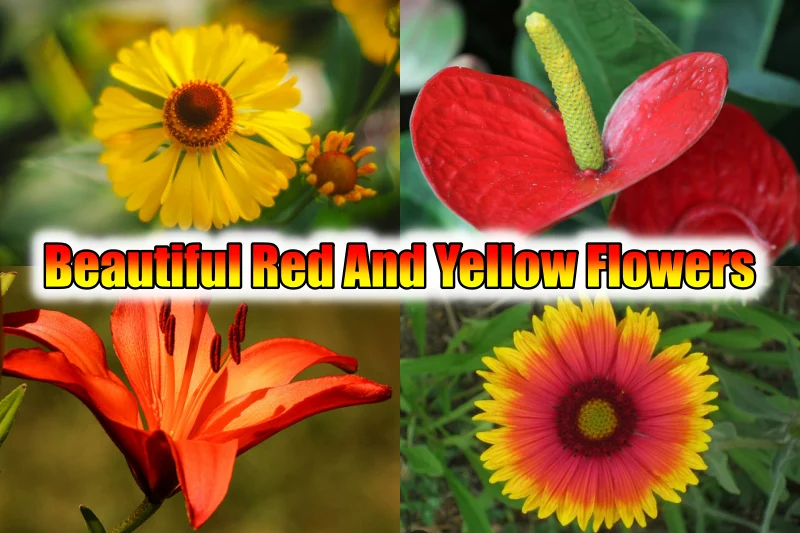Plan on starting a new garden or enhancing the one you already have with something both vibrant and mellow at the same time? And you also seem to be someone who has a balanced taste in life, so don’t worry; we have the best solution for you. While red will bring out your fierce nature, yellow will help you tone down a notch.
After careful consideration, we have here for you a comprehensive list of the 20 most beautiful red and yellow flowers to attract the bees and neighbors likewise!
This list is comprised of low-maintenance plants, some of which have aesthetic value as well as nutritional value, and a few of which even have medicinal value.
20 Beautiful Red And Yellow Flowers For Your Garden
1) Peruvian Lily
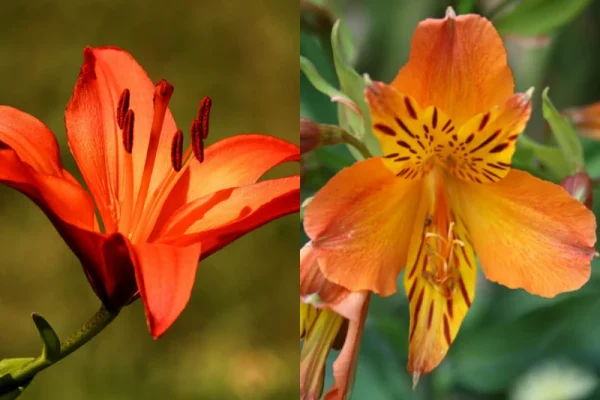
| Scientific Name | Alstroemeria aurea |
| Geographic Origin | Chile, Argentina, Australia, New Zealand, and the United Kingdom. |
| Size | 16 to 20-inch |
| Identification | The petals of the flowers have a conoidal shape and are a color that is somewhere between reddish-orange and orange, with a yellow throat and deep burgundy streaks. |
An exotic and beautiful flower, which bears resemblance to a lily, hence the name- Peruvian Lily. They do best in soil that is rich in nutrients, has good drainage, and is slightly moist.
Because they are easy to cultivate, they are said to be the gardener’s best friend. They grow in clusters varying from yellow to red making them one of the best plants for your backyard!
2) Flamingo Lily

| Scientific Name | Anthurium andraeanum |
| Geographic Origin | Colombia and Ecuador |
| Size | 12 to 18 inches |
| Identification | Flowers have a spathe in the shape of a heart, and the spadix is yellow. |
Starting with a delicate pink and maturing into a vibrant red. These flowers are usually red while the color of the spadix can vary from cream to bright yellow.
If taken care of, this magnificent plant can bear up to 4-6 flowers year-round. According to the ancient history, asters were created by the goddess Astraea.
They need filtered lights and consistent moisture, making them a little high maintenance.
3) Aster Crimson Brocade
| Scientific Name | symphyotrichum novi-belgii (crimson brocade) |
| Geographic Origin | Eastern Canada and the northeastern United States, New England |
| Size | 36-60 inches |
| Identification | The petals are a mulberry red/crimson color, and the center is a bright yellow. |
Lovingly called the Royal Ruby of the Plant Kingdom it blooms into the most breathtaking, eye-catching red/crimson color with a beautiful yellow-gold center.
Aster is a plant that should absolutely be included in your garden if you are the type of person who enjoys having birds and bees stop by on a regular basis.
In addition to this, they have a long lifespan and are simple to cultivate in a variety of environments.
4) Scarlet Begonia
| Genus | Begonia |
| Geographic Origin | South and Central America, Africa, and southern Asia |
| Size | 12-14 inches |
| Identification | Flowers of a scarlet red color with a yellow center. |
With a whopping 2,000 different plants belonging to the species, the majority of these plants are grown for their ornamental value.
These particular ones have the appearance of a carnation because the flowers grow in the shape of large blossoms.
Their petals, in contrast to those of carnations, have a more crumpled edge. They are low-maintenance, but it is necessary to have adequate air circulation.
5) Bleeding heart
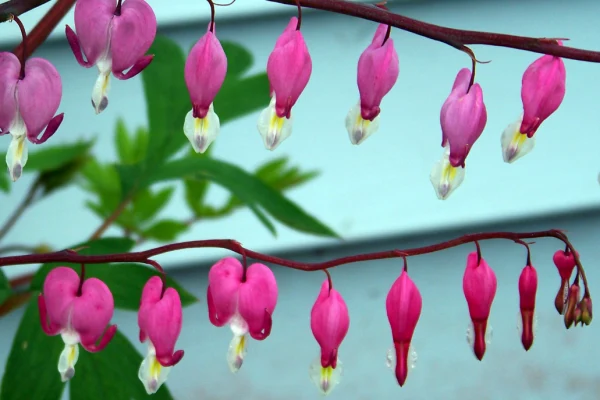
| Scientific Name | Lamprocapnos spectabilis |
| Geographic Origin | Siberia, northern China, Korea, and Japan |
| Size | 30 inches |
| Identification | Flower in the shape of a heart that has white petals that protruding and yellow spots on them. |
Screams anime to me! They hold a high value due to their unique shape and color bearing distinct pinkish-red heart-shaped flowers with a white droplet-like protrusion with bright yellow streaks.
They will grow to their full potential if they have access to sufficient sunlight and water.
They grow best in soil rich in humus. However, do not be fooled by their appearance, it has been known to cause discomfort on ingestion.
6) Red Calla Lily

| Scientific Name | Zantedeschia aethiopica |
| Geographic Origin | South Africa |
| Size | 14 to 18 inches |
| Identification | Flower is in the shape of a trumpet, reddish-orange in color, with a yellow stalk running through the middle of each flower. |
They have a unique trumpet shape with a beautiful and cheerful shade of red and a bright yellow stick-like stalk making them one of the best choices for a wedding.
Traditionally white, breeders focus on modern hybrids with vibrant colors for monetary purposes.
They are available in a variety of colors, ranging from white to a stunningly dark black color. Low-maintenance making them a gardener’s best choice.
7) Camellia
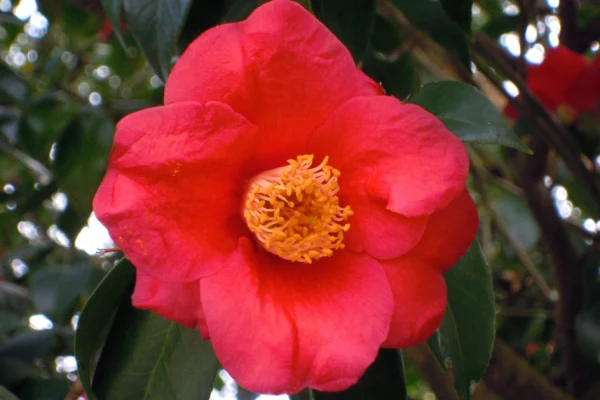
| Scientific Name | Camellia japonica |
| Geographic Origin | China, Taiwan, southern Korea, and southwestern Japan |
| Size | 6 to 8 feet |
| Identification | Petals are ruffled and have yellow-golden stamens in the center of the flower |
They come in a variety of shapes, sizes, and colors and are known for their rich history. They fully blossom during the spring season, with their effect lasting throughout winter.
Flowers like these typically require low maintenance, but they do need to be shielded from the damaging effects of direct sunlight and pests.
They might also require appropriate air conditioning in order for you to keep fungus away from them.
8) Columbine
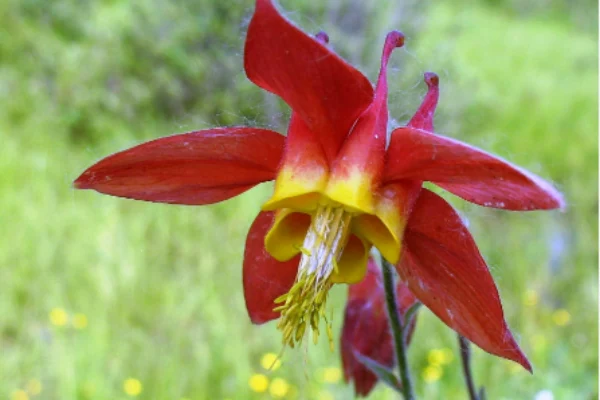
| Scientific Name | Aquilegia canadensis |
| Geographic Origin | Eastern North America |
| Size | 6-35 inches |
| Identification | Flowers are in the shape of tubes and have red petals and a yellow center |
These flowers will not only add an artistic touch to your garden but will also help you cure headaches, sore throat, fever, and rash caused by poison ivy, kidney, and urinary problems.
‘Aquila’ in Latin means eagle, referring to the flower’s eagle’s talon-like flowers.
The shape of these flowers and the copious amount of nectar produced by them are known to attract hummingbirds and butterflies.
9) Red Cosmos
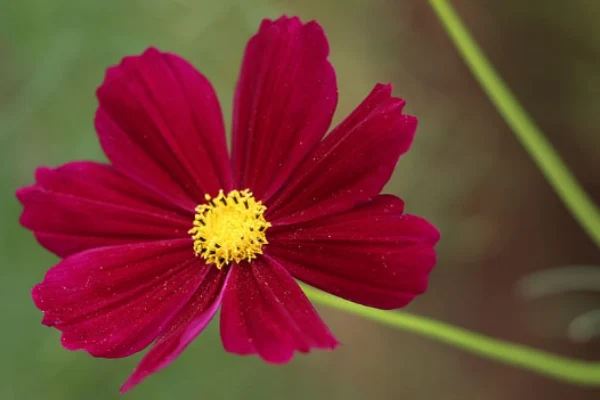
| Scientific Name | Cosmos ulphureus |
| Geographic Origin | Mexico |
| Size | 20 inches |
| Identification | The plant has soft red flowers with a yellow center |
Also called Rubenza, because of its sturdy look and ruby red flowers, which resemble the gemstone.
The color of the flower can range from orange to white, while the color of the foliage stays a consistent yellowish gold throughout the growing season.
They are low-maintenance and attract birds and butterflies making it yet another excellent choice for your garden.
10) Yellow Hibiscus
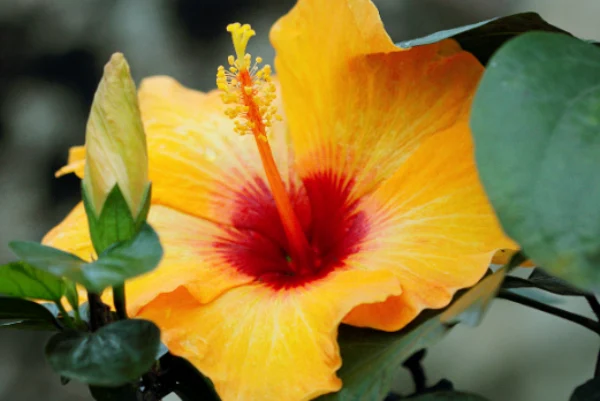
| Scientific Name | Hibiscus brackenridgei |
| Geographic Origin | Warm temperate, subtropical, and tropical regions |
| Size | 15 to 30-foot (tree) |
| Identification | Yellow fragrance-free flower with red center |
Hawaii’s state flower and why not! These beautiful flowers add both ornamental and medicinal value.
The petals can vary from white to pink, red, blue, yellow, or peach.
The flowers are used to make a tea that has a distinct sour taste and contains a high concentration of vitamin C. These plants are currently listed as endangered.
11) Trailing abutilon

| Scientific Name | Abutilon megapotamicum |
| Geographic Origin | Argentina, Brazil, and Uruguay |
| Size | 8 ft (tree) |
| Identification | Lantern-shaped flowers with a red base that are attached to the stalk of the flower. |
Flowers are yellow with a red base resembling a Chinese lantern. It starts blooming in the summer and continues until the first frost.
During the winter months, when the harsh cold weather and frost are avoided.
The plants have a generally short lifespan, and they need to be trimmed on a regular basis after they flower.
12) Lady Tulip
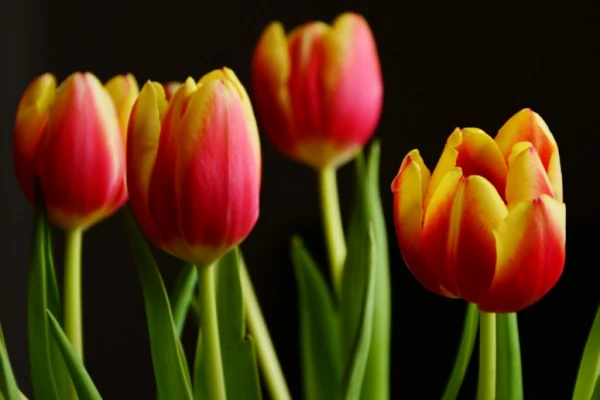
| Scientific Name | Tulipa clusiana ‘Cynthia’ |
| Geographic Origin | Iraq, Iran, Afghanistan, Uzbekistan, Pakistan, and the western Himalayas |
| Size | 0.75 to 1.00 ft |
| Identification | Bi-colored bulb-shaped flowers |
A perfect blend of flame red and pale-yellow flowers, they are wide open on sunny days and the blossoms close at night. Grow best in rich, fertile, and well-drained soil.
They are florist’s favorites, grown for their attractive and vibrant colors. There are currently 3,000 registered varieties.
13) Kohleria
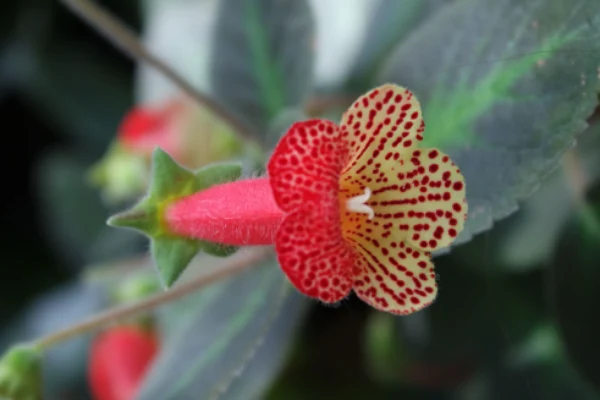
| Scientific Name | Kohleria amabilis var. bogotensis |
| Geographic Origin | Central America and South America |
| Size | 12-18 inches |
| Identification | Flowers are of brilliant red color with a contrasting yellow hue. |
This beautiful and eye-catching flowering plant is a hybrid created by John Boggan. The stems of the plants are velvety, and the flowers have spots that contrast with their background color.
Several of these species tend to grow in the wild and hybridize fast. After completely vanishing in the early part of the 20th century, plant breeders have only relatively recently begun to cultivate these flowers again.
14) Velvet trumpet flower
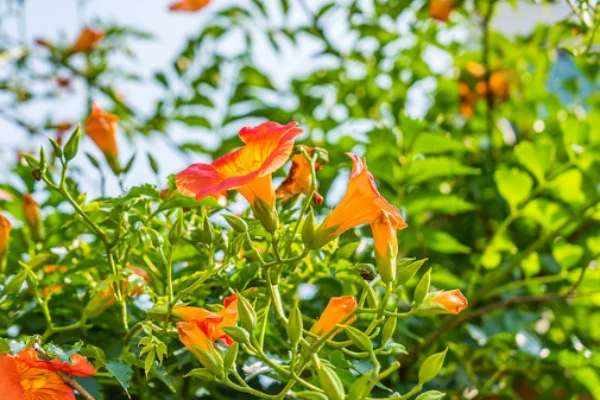
| Scientific Name | Salpiglossis sinuata |
| Geographic Origin | Southern Chile |
| Size | 2 ft |
| Identification | Curly leaves with a corolla in the shape of a funnel |
The flowers of this short-lived perennial plant have a corolla that is in the shape of a funnel and has five lobes.
The corolla has a peculiar velvety texture and can be either red or purple in color. Yellow stripes run along each petal, giving the flower a distinctive appearance.
They bloom well in full sunlight in areas with cool summer temperatures. Mainly cultivated for their ornamental and aesthetically pleasing appearances.
15) Zinnia

| Scientific Name | Zinnia elegans |
| Geographic Origin | Mexico |
| Size | 5.27 in |
| Identification | Giant red flower heads with bright yellow pom-poms in the center |
Due to their diverse array of colors, they are very popular among cultivators. These garden-friendly flowers.
Usually found in the wild, they were soon hybridized and cultivated for their bright and colorful flowers. Grows best in soil that has good drainage and is exposed to full sun.
They are drought-tolerant but require a frost-free environment to thrive.
16) Gerbera
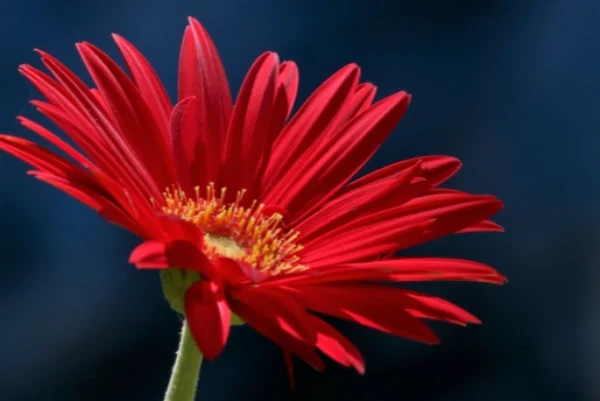
| Scientific Name | Gerbera jamesonii |
| Geographic Origin | Africa |
| Size | 10-12 in |
| Identification | Hybrids have vibrant red colored leaves with a yellow center |
The petals come in various colors with a contrasting center. They require very little attention and a little bit of care, making them a wonderful addition to any garden.
These flowers bloom throughout the entire summer, and their blooming period can last for several weeks. The plant itself can grow to a maximum height of 12 inches.
17) Blanket Flower

| Scientific Name | Gaillardia x grandiflora |
| Geographic Origin | North and South America |
| Size | 20 in |
| Identification | Daisy-like flowers with shades of red and yellow |
Though short-lived they make an amazing addition to your garden as their vibrant colors attract butterflies.
They are fast growers and blooms throughout summer with large blooms. And if you are just starting out, worry not as these perennial plants start flowering in the second year of being planted as a seed.
However, these plants are known to have slight toxicity to humans.
18) Nasturtium
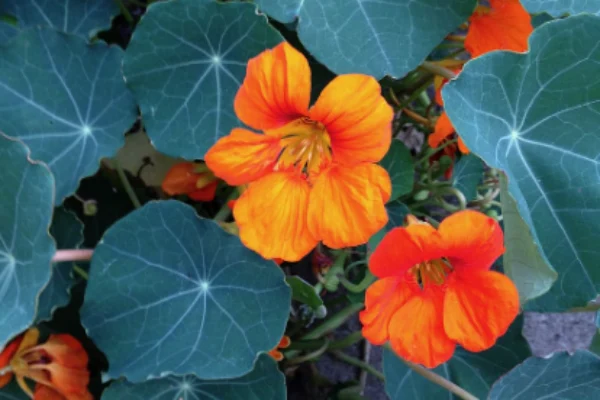
| Scientific Name | Tropaeolum majus |
| Geographic Origin | South and Central America |
| Size | 1-10 ft |
| Identification | Trumpet-shaped blooms in the shade of reddish orange with a yellow center |
Quick-growing climbers with blooms in the shades of red, yellow, and orange and center in the shade of bright or pale yellow. The most common being in the shade of red.
As long as you provide them with an adequate amount of water and soil that drains well, they are good to go! These lovely things aren’t just for looks; they also have a purpose in the kitchen as a tasty addition to salads.
19) Sneezeweed
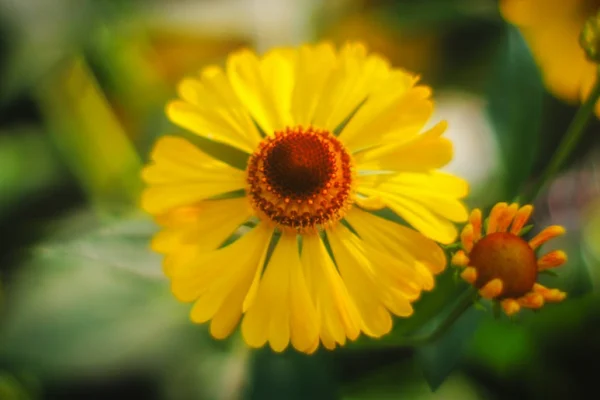
| Scientific Name | Helenium autumnale |
| Geographic Origin | America |
| Size | 6.6 ft |
| Identification | Bears yellowish-orange daisy-like flowers with red center |
Most flowering plants in this species tend to have a globe-like disk-shaped flower. An easy-to-grow flower that enjoys spending time in the sun and has the potential to bring a splash of color to your garden. This plant was named after Helen of Troy.
The name sneezeweed was given to it for its property to replicate the nicotine-like effect when crushed to make a snuff that caused sneezing.
In certain cultures and times, sneezing was regarded as a desirable way to rid the body of evil spirits or to loosen up a head cold.
20) Treasure Flower
| Scientific Name | Gazania rigens |
| Geographic Origin | South Africa |
| Size | 1 ft |
| Identification | Large composite flowers with daisy-like yellow flowerheads with reddish-brown streaks |
Low-maintenance flowers with the ability to elevate your garden by a great margin!
These extravagant blooms tend to attract butterflies due to the bright yellow and deep plum-colored flowers that they bear.
They are hardy in nature and will recover from a light frost to their natural glory.
Conclusion
This article was written to offer readers a brief overview of red and yellow flowers to level up their gardening game.
Consisting of beginner-friendly to a few expert-level flowers, we have tried to make this list suitable for anyone and everyone looking to start fresh or add a few plant babies to their already beautiful garden!
Also Read:

Hi everyone, my name is Shawna, and I’ve always been fascinated by the fascinating diversity of flora and fauna that our nature has in it. I am currently studying biotechnology and am particularly interested in animal biotechnology, delving into the intricate processes that define their true nature and uniqueness.
